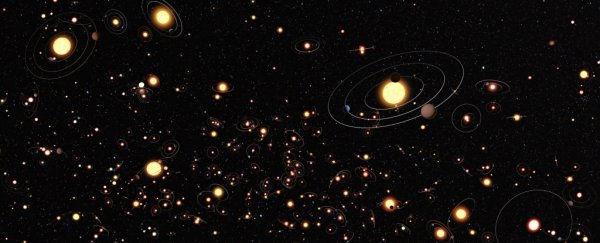As our stargazing abilities grow ever more advanced, astronomers have been finding more and more extrasolar planets.
But there's a lot of stuff swirling out in the Universe that falls somewhere in between, and one astrophysicist is calling for a formal definition on what being a planet really means.
We know what makes a planet within the Solar System, partially because poor Pluto got flicked from the club for not having cleared its path of orbit around the Sun. According to the International Astronomical Union:
"A 'planet' is a celestial body that (a) is in orbit around the Sun, (b) has sufficient mass for its self-gravity to overcome rigid body forces so that it assumes a hydrostatic equilibrium (nearly round) shape, and (c) has cleared the neighbourhood around its orbit."
That definition cannot include exoplanets, since they don't orbit the Sun, but we're also finding things outside the Solar System that are confusing matters in the opposite way to Pluto - namely, brown dwarfs, which no one seems able to decide whether they are enormous planets or tiny stars.
There's no proper definition of an exoplanet - only a working definition laid out by the IAU Working Group on Extrasolar Planets in 2003.
That working definition says that any object that is smaller than a star, but large enough to produce deuterium fusion, is a brown dwarf - neither a planet nor a star.
According to Kevin Schlaufman, an astrophysicist at Johns Hopkins University, that definition is too inconsistent, since deuterium burning varies depending on the composition and internal properties of the object.
Schlaufman, whose proposal was published in The Astrophysical Journal, suggests looking at the object's immediate surroundings, because that can tell us how it formed - and formation could be the key we use to distinguish brown dwarfs from planets.
"Under a formation-based definition, planets are celestial bodies that form through core accretion. Conversely, brown dwarfs and stars form through direct gravitational collapse, either at the disk or core scale," he explained in his paper.
"Despite the appeal of this definition, it has not been put into practice because of the difficulty in observationally determining the origin of individual celestial bodies orbiting distant stars."
Now that we've observed many planetary systems around stars, we have a better idea of the patterns involved, and those can be the key to determining whether an object formed via core accretion (building up) or gravitational collapse (top-down).
According to Schlaufman's paper, the star around which a planetary system orbits can be very revealing. Giant, Jupiter-like planets are almost always found orbiting iron-rich stars, while brown dwarfs are a lot more varied.
This is because stars with heavier elements in their accretion discs are more likely to be able to build planets from the core up. Brown dwarfs, on the other hand, are made from clouds of gas and dust.
And it seems there's a pretty clear mass cut-off point between the two. By studying 146 planetary systems, Schlaufman found that, upwards of a mass about 10 times that of Jupiter, objects do not show a connection with stars that are rich in heavy elements - and are therefore unlikely to make planets.
"These data suggest that core accretion rarely forms giant planets with [masses greater than 10 Jupiters] and objects more massive than [10 times the mass of Jupiter] should not be thought of as planets," he concluded.
Instead, in the absence of any better data, objects with masses greater 10 times that of Jupiter should be considered brown dwarfs.
Boy, that planet club is choosy. And it doesn't look like Pluto will be let back in ever again.
The paper has been published in The Astrophysical Journal, and can be read in full on preprint resource arXiv.
